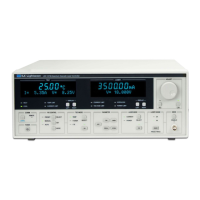December 2019 31 LDC-3706 Series Laser Controller
Operating the Temperature Controller from the Front Panel
General Guidelines for Sensor Selection and Safety Limits
This section presents some guidelines to assist in selecting the optimal settings for an
application.
Sensor Options
The LDC-3706 Laser Controller can measure temperature through a variety of sensor options;
thermistors, IC sensors (IC-I, IC-V) or RTDs.
THERMISTOR – When a thermistor sensor is selected, the LDC-3706 instrument measures
temperature based on a negative temperature coefficient (NTC) thermistor. An NTC thermistor
is a device whose resistance decreases as its temperature increases. The controller provides a
sense current (100 µA or 10 µA) through the thermistor which results in a voltage across the
thermistor. This voltage is used as a feedback signal by the LDC-3706 digital control loops to
maintain a constant temperature. The thermistor should be connected across the Sensor+ and
Sensor- pins (LDC-3736 & LDC-37620: Pins 1 & 2, LDC-3726: Pins 7 & 8 of the TEC output
connector).
When using a thermistor in constant temperature mode, the quantity that is maintained constant
by the controller is the sensor resistance. In constant temperature mode, the LDC-3706
converts the temperature setpoint to a thermistor resistance setpoint using user defined
constants.
The Steinhart-Hart equation is used to convert a temperature to a resistance for thermistor
sensors. The equation describes the non-linear resistance versus temperature characteristics of
typical thermistors. Calibrating a thermistor consists of measuring its resistance at various
temperatures and fitting this measured data to the Steinhart-Hart equation. The resulting
coefficients C
1
, C
2
, and C
3
effectively describe the thermistor for a specific temperature range.
For more information about the Steinhart-Hart equation, see ILX Lightwave Application Note #4
Thermistor Calibration and the Steinhart-Hart Equation.
To measure the precise temperature of a load, a calibrated sensor must be used. For example,
when using a thermistor, enter its Steinhart-Hart coefficients C
1
, C
2
, and C
3
into the temperature
controller. If the exact temperature is not crucial (within ±1.5°C) and a 10 k thermistor is being
used, use the default constants provided by the LDC-3706.
Thermistor resistance changes with temperature. The LDC-3706 supplies a constant current,
either 10 µA or 100 µA, through the thermistor so that a temperature change results in a voltage
change across the thermistor. This voltage change is sensed by the instrument and fed back to
the control loop. The supply current selection depends on the thermistor operating temperature
range and the required temperature resolution. A general rule of thumb for a 100 k thermistor
is to use the 10 µA range for temperatures between -30°C and +30°C and for 10 k thermistor
the 100 µA range for temperatures between 10°C to 70°C. Select the thermistor sense current
of 10 µA or 100 µA in the front panel TEC parameter menu. Using 10 µA as the thermistor
current allows a maximum thermistor resistance of 450 k to be used. The 100 µA setting
allows a 45 k maximum.

